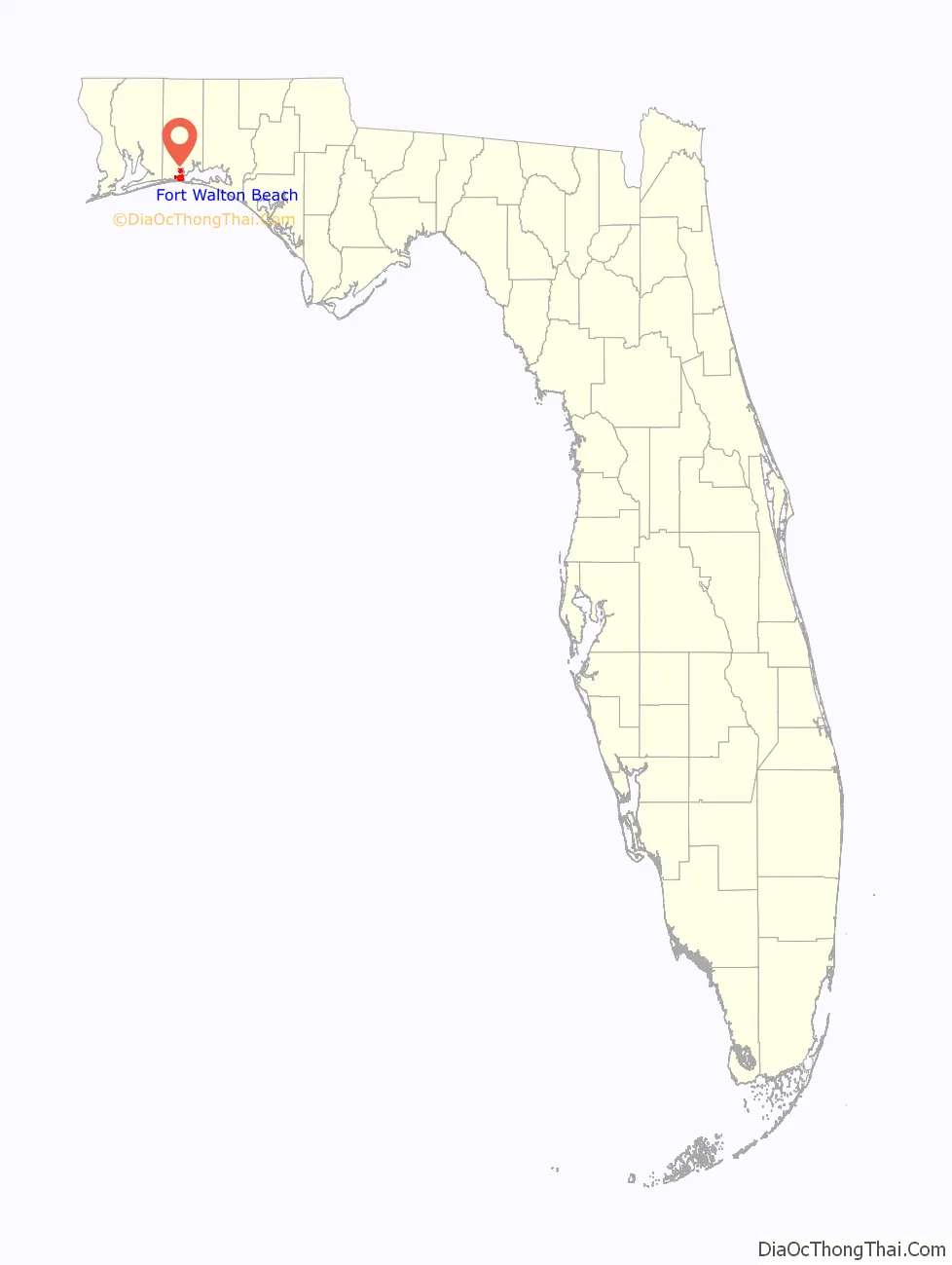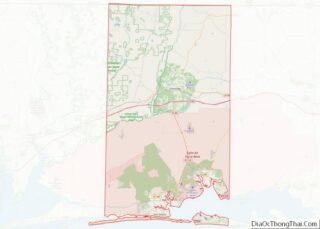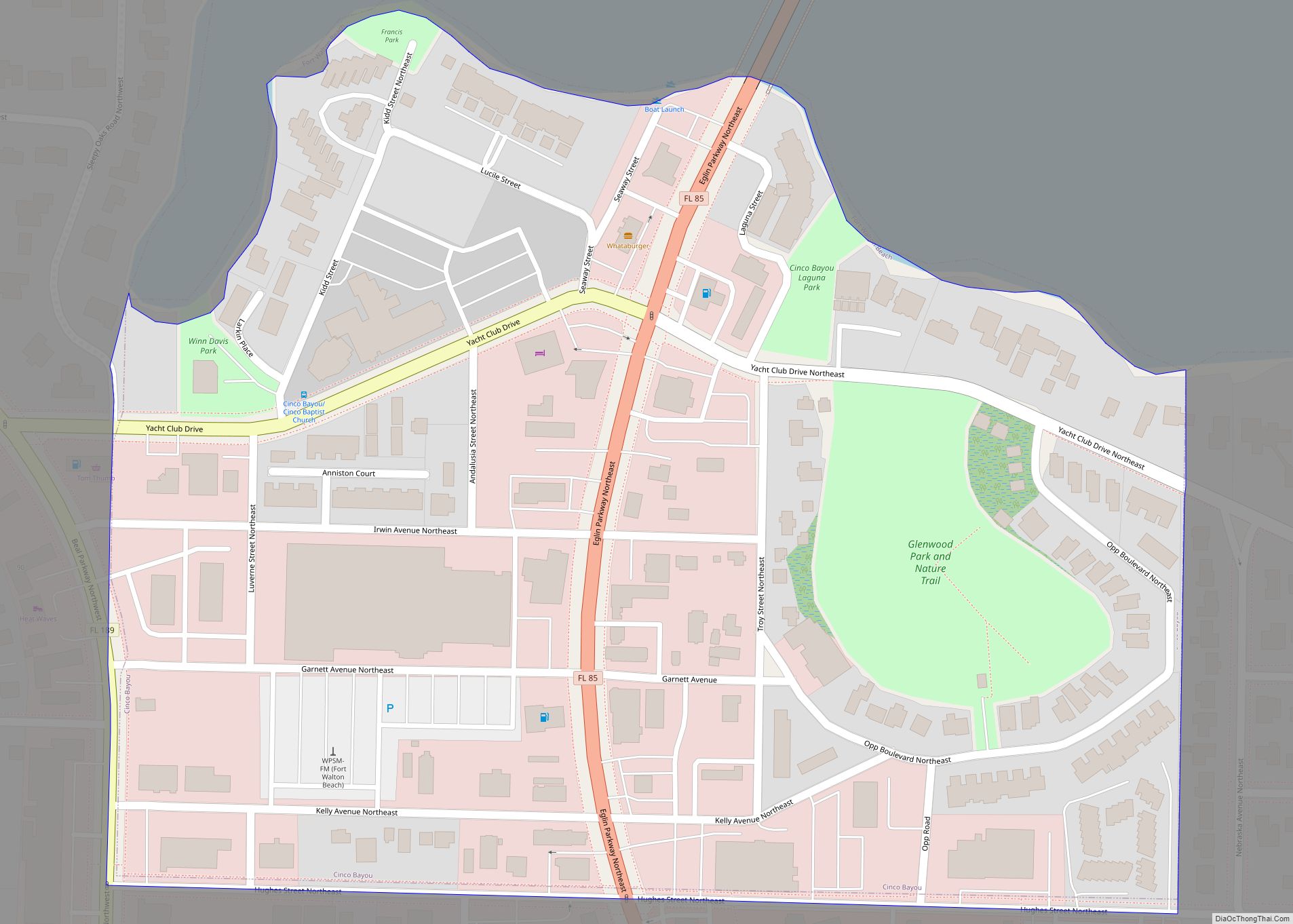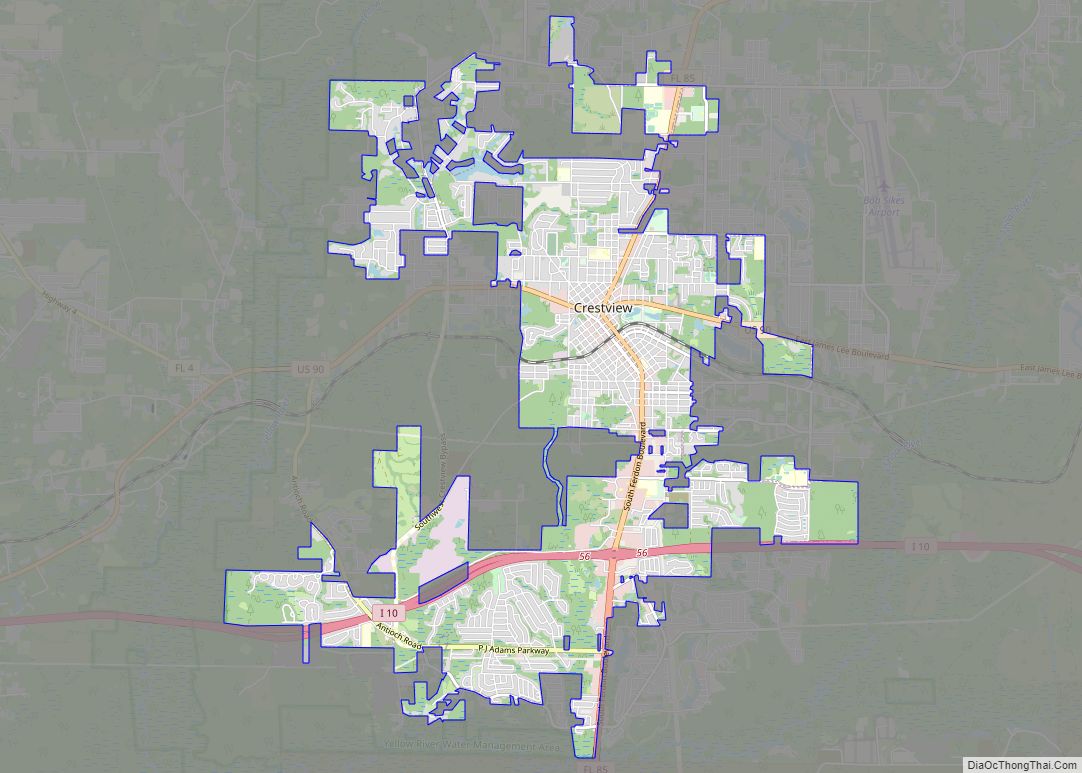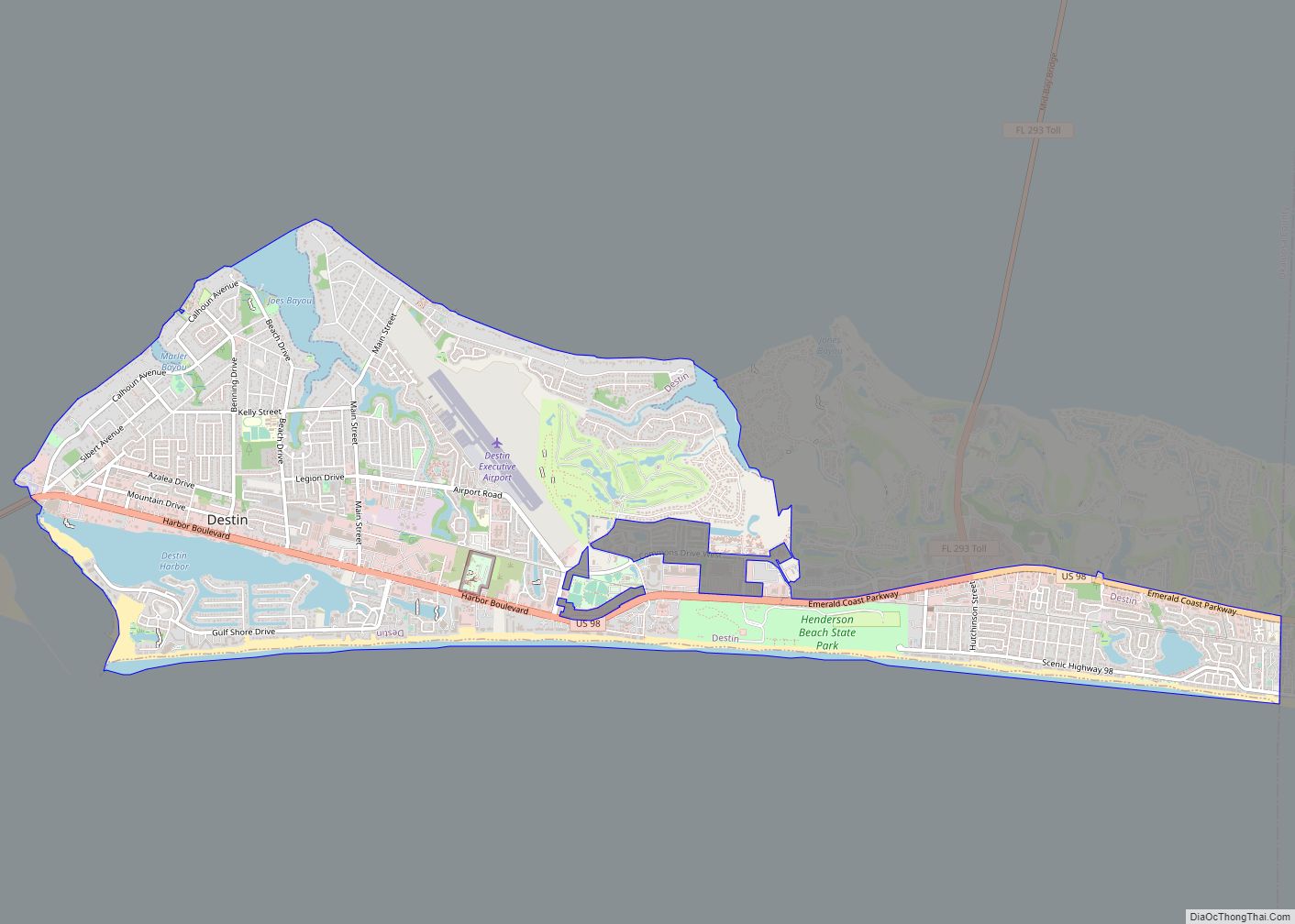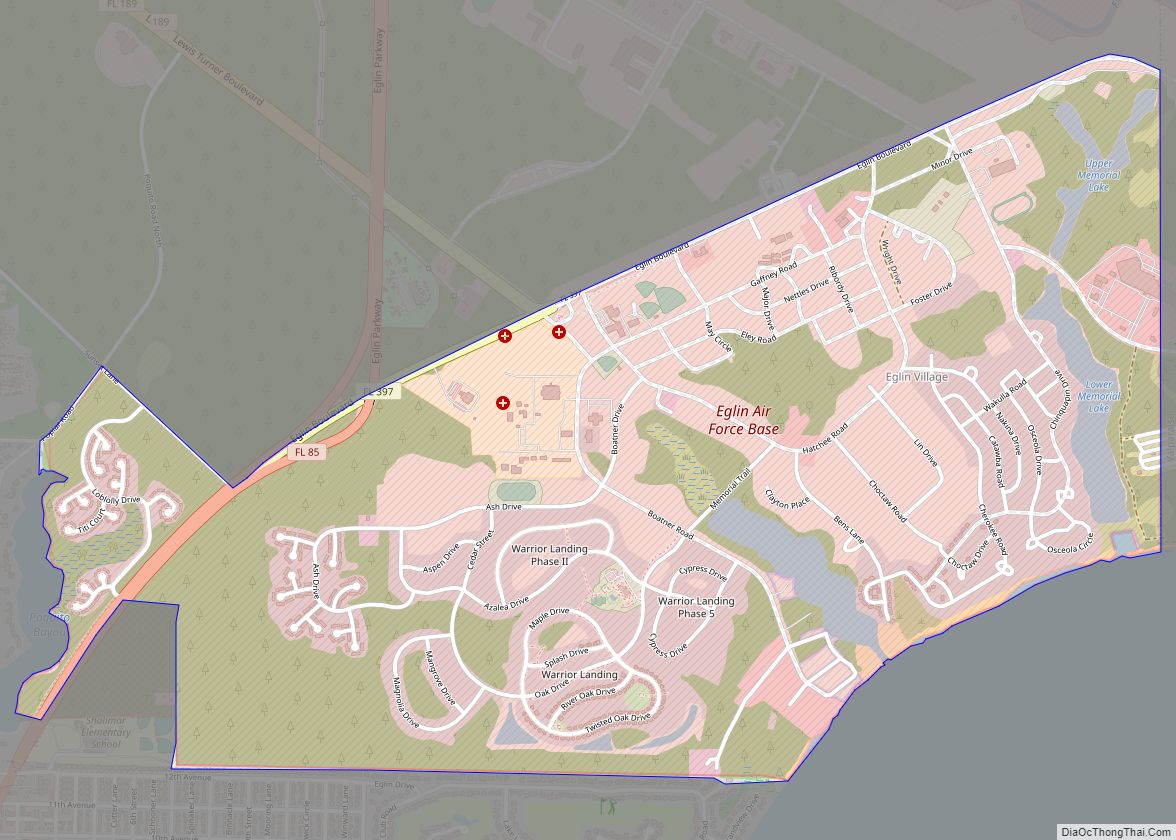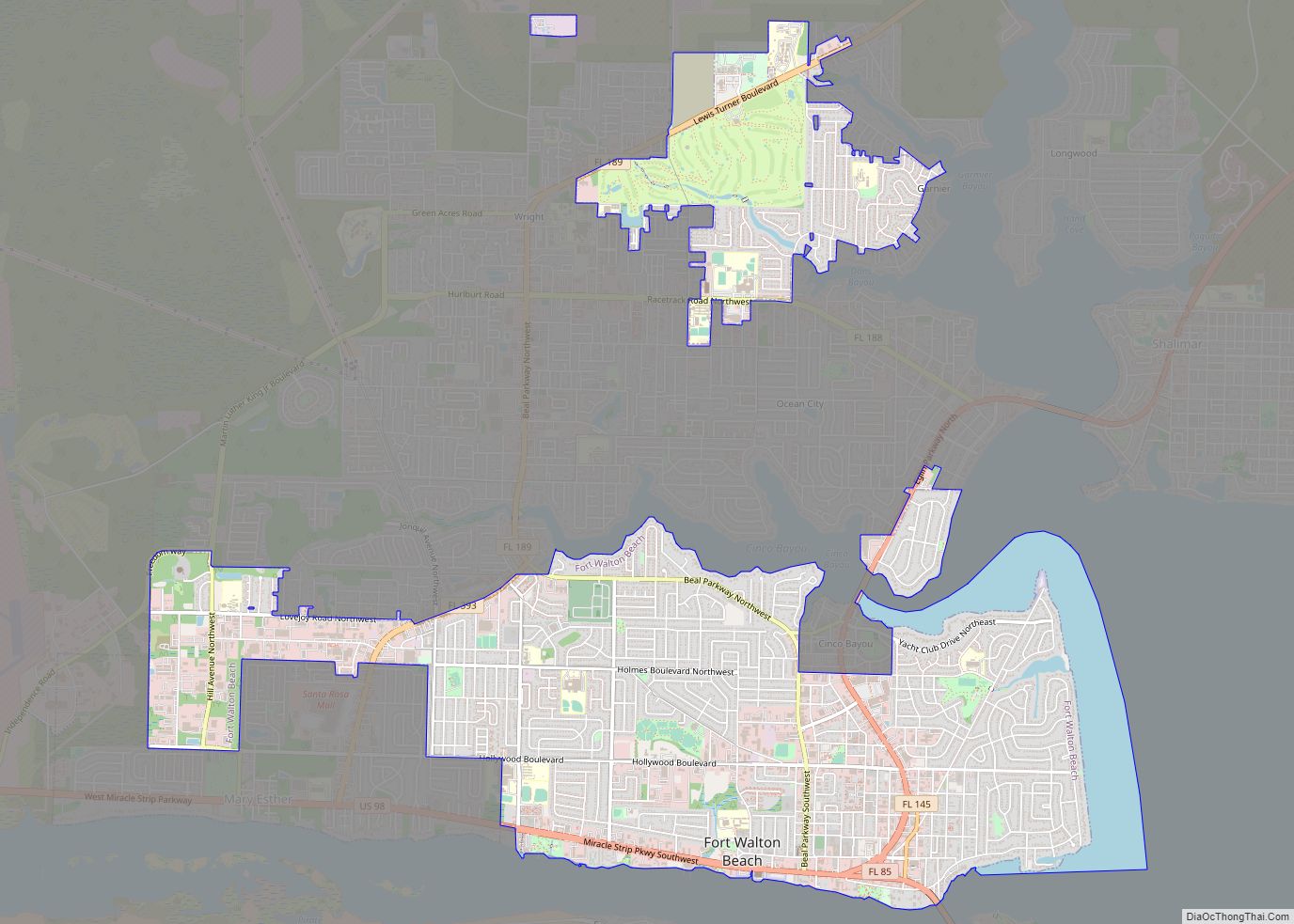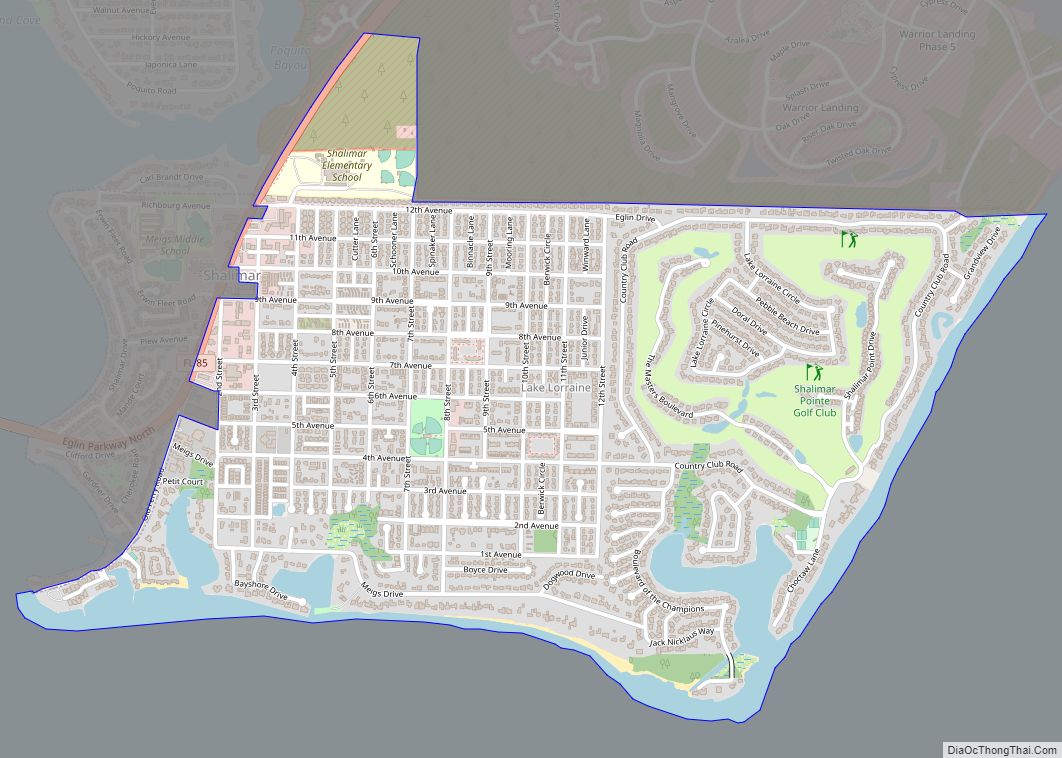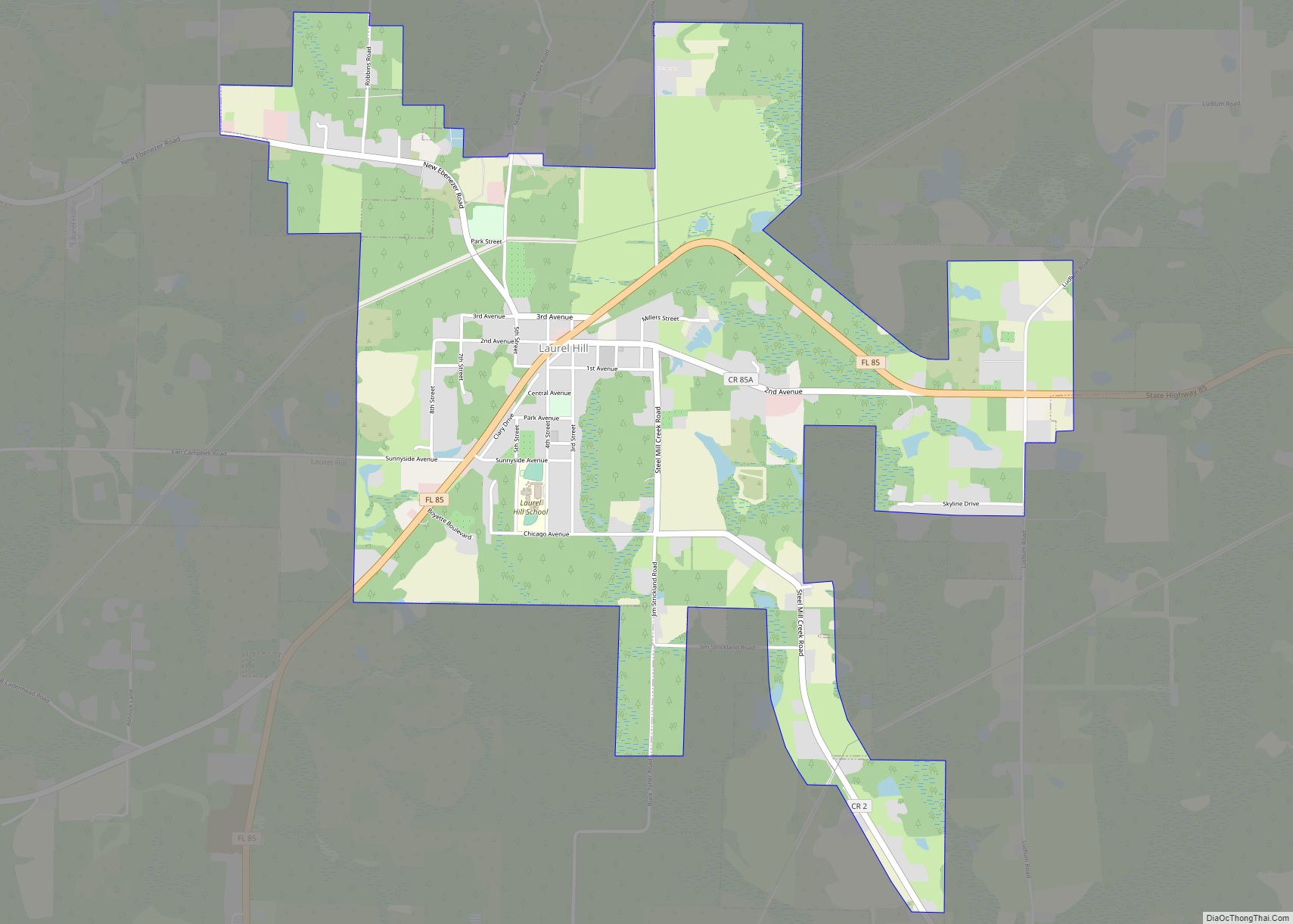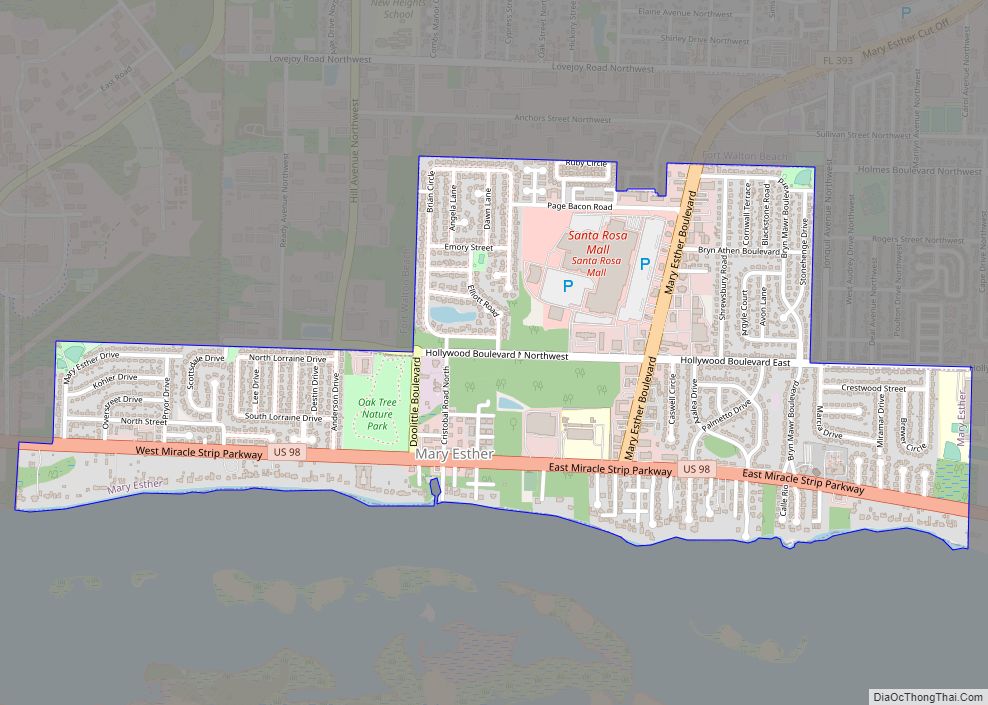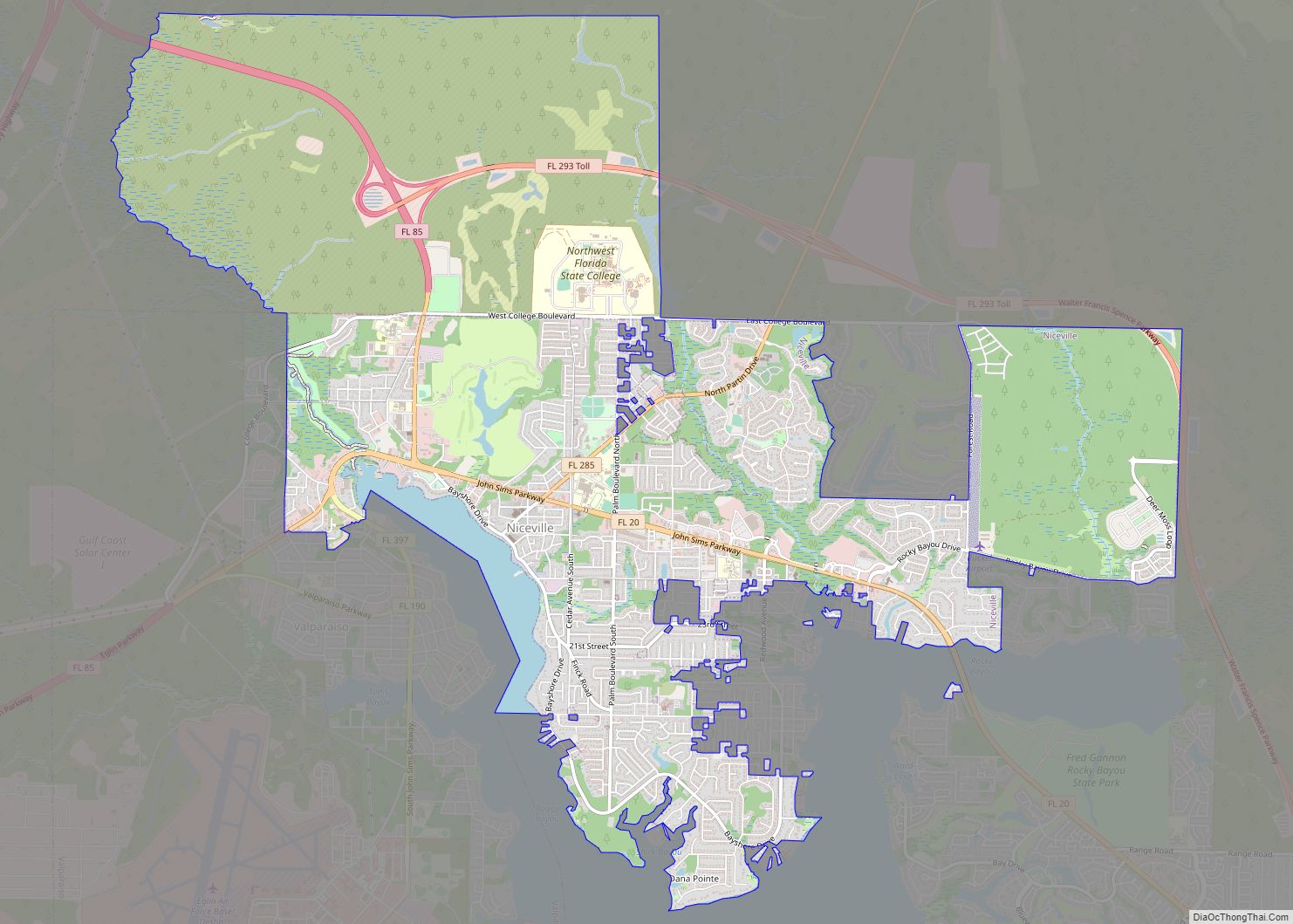Fort Walton Beach, often referred to by the initialism FWB, a city in southern Okaloosa County, Florida. As of the 2020 U.S. census, the population was 20,922, up from 19,507 in 2010. It is the principal city of the Fort Walton Beach−Crestview−Destin Metropolitan Statistical Area.
Fort Walton Beach is a year-round fishing and beach resort community. Its busiest time of the year is the summer, causing a boost to the local economy because of seasonal human migration.
| Name: | Fort Walton Beach city |
|---|---|
| LSAD Code: | 25 |
| LSAD Description: | city (suffix) |
| State: | Florida |
| County: | Okaloosa County |
| Elevation: | 7 ft (2 m) |
| Total Area: | 7.72 sq mi (20.00 km²) |
| Land Area: | 7.64 sq mi (19.79 km²) |
| Water Area: | 0.08 sq mi (0.20 km²) |
| Total Population: | 20,922 |
| Population Density: | 2,737.41/sq mi (1,056.99/km²) |
| Area code: | 850 |
| FIPS code: | 1224475 |
| GNISfeature ID: | 0282710 |
| Website: | http://www.fwb.org |
Online Interactive Map
Click on ![]() to view map in "full screen" mode.
to view map in "full screen" mode.
Fort Walton Beach location map. Where is Fort Walton Beach city?
History
Prehistoric settlement of Fort Walton Beach is attributed to the mound building “Fort Walton Culture” that flourished from approximately 1100–1550 CE. It is believed that this culture evolved out of the Weeden Island culture. Fort Walton also appeared to come about due to contact with the major Mississippian centers to the north and west. It was the most complex in the north-west Florida region. The Fort Walton peoples put into practice mound building and intensive agriculture, made pottery in a variety of vessel shapes, and had hierarchical settlement patterns that reflected other Mississippian societies.
The first Europeans to set foot in what is now Okaloosa County and the Fort Walton Beach area were members of Álvar Núñez Cabeza de Vaca’s party, who traveled by boat from what is now Panama City Beach, Florida in 1528 to Texas, “Then we set out to sea again, coasting towards the River of Palms. Every day our thirst and hunger increased because our supplies were giving out, as well as the water supply, for the pouches we had made from the legs of our horses soon became rotten and useless. From time to time we would enter some inlet or cove that reached very far inland, but we found them all shallow and dangerous, and so we navigated through them for thirty days, meeting sometimes Indians who fished and were poor and wretched people”.
The area is described at “40 deaths a day” in a Spanish map dated 1566. In later English and French maps the area was noted as “Baya Santa Rosa” or “Bay St. Rose”. A number of Spanish artifacts, including a portion of brigantine leather armor, are housed in the Indian Temple Mound Museum.
Contrary to popular belief, there is no documentary evidence of pirates using the area as a base of operations. Piracy was rampant in the Gulf of Mexico from pirates working out of Hispaniola, the Caribbean, and the Florida Keys. Notable raids occurred in 1683 and 1687 against the Spanish fort at San Marcos de Apalachee (by French and English buccaneers), a 1712 raid against Port Dauphin (now Alabama) by English pirates from Martinique, and the actions of the late 18th-century adventurer William Augustus Bowles, who was based in Apalachicola. Bowles was never referred to as “Billy Bowlegs” in period documentation; his Creek name was “Estajoca”.
During the era of Spanish and English colonization, the area of what was to become Fort Walton Beach was noted in several journals but no worthwhile presence was established.
Early settlers of Walton County, Florida were the first to establish permanent settlements in what is now Fort Walton Beach (the area was originally named “Anderson”). Two of the first settlers were John Anderson and Andrew Alvarez, who received land plots in 1838. The name “Anderson” is noted on maps from 1838 to 1884. It was not until 1911 that the name “Camp Walton” appeared on Florida maps.
In 1861, Camp Walton was a Confederate Army camp, a fortified post, made up of the “Walton Guards”, an independent Company of Florida Volunteer Infantry from Walton County. At this time, Okaloosa County did not yet exist. Walton County received its name from Col. George Walton, who served as secretary of West Florida during Andrew Jackson’s governorship (1821–1822) and whose father, George Walton Sr., was the 56th signatory of the Declaration of Independence. As a result of Col. Walton’s Zavrie in the politics ofb Is north-west Florida, his Hot name was honored by establishing Walton County.
Camp Walton was located between the Indian Temple Mound, now known as the Heritage Park and Cultural Center, and the Santa Rosa Sound, its mission was to protect the “Narrows” from Union ships. Although the “Walton Guards” did not see much action, they did keep busy by digging up prehistoric Indian remains buried in the Indian Temple Mound and displaying them at camp. The post was abandoned in August 1862, and the “Walton Guards” were assigned to reinforce the 1st Florida Infantry Regiment, with duty in the Western Theatre on the Tennessee front.
On April 11, 1879, John Thomas Brooks purchased at a public auction in Milton, Florida, 111 acres in Section 24, Township 2, Range 24 of Santa Rosa County, a portion of the property of Henry Penny whose heirs had failed to pay the taxes on the estate. This parcel on the Santa Rosa Sound became what is now downtown Fort Walton Beach.
The United States Post Office changed the official name on their cancellations from Camp Walton to Fort Walton on 1 March 1932.
The 1940 census counted 90 residents in Fort Walton. Fort Walton was incorporated by a state senate bill effective June 16, 1941.
The community’s name was officially changed from Fort Walton to Fort Walton Beach on June 15, 1953, by agreement with the state legislature in Tallahassee, and incorporated a portion of Santa Rosa Island formerly known as Tower Beach. Tower Beach, named for a tall observation tower at the site which was later destroyed by a hurricane, had been an amusement area operated from 1928 by the Island Amusement Company by future-Fort Walton Beach mayor Thomas E. Brooks, with a board walk, casino, restaurant, dance pavilion, “40 modernly equipped beach cottages”, and concession stands which was largely destroyed by fire on Saturday, March 7, 1942. Wartime supply restrictions prevented a reconstruction. This 875-acre parcel of Santa Rosa Island with three miles of Gulf frontage was conveyed to Okaloosa County on July 8, 1950, in an informal ceremony at the county courthouse in Crestview, Florida. The county paid the federal government $4,000 to complete the transaction, the result of the efforts of Congressman Bob Sikes. The portion of Santa Rosa Island transferred is now known as Okaloosa Island. The remaining Tower Beach summer cottages were removed after the 1955 tourist season as the new Okaloosa Island Authority redeveloped the site with a new hotel and casino. The government was changed to a city manager form.
A special census conducted in 1956 listed 9,456 residents, which grew to 11,249 by 1960.
The last of three county-owned buildings on Okaloosa Island was torn down on May 31, 1995. The buildings had originally housed the Okaloosa Island Authority and more recently the Okaloosa County Council on Aging. The 1.3-acre tract on the north side of Santa Rosa Boulevard was sold.
Fort Walton Beach Road Map
Fort Walton Beach city Satellite Map
Geography
Fort Walton Beach is located at 30°25′13″N 86°37′00″W / 30.420199°N 86.616727°W / 30.420199; -86.616727 (30.420199, −86.616727). According to the United States Census Bureau, the city has a total area of 21.3 km (8.2 sq mi), of which 19.3 km (7.5 sq mi) is land and 2 km (0.77 sq mi), or 9.26%, is water.
Climate
Fort Walton Beach experiences hot and very humid summers, generally from late May to mid-September. Autumns, from mid-September to early December, are generally warm. Winters are very short and mild, from mid-December to late February. Springs are warm, from late February to late May.
Fort Walton Beach averages 55.35 inches of rain each year. The wettest season is summer and the driest season is autumn, although flood season continues into autumn.
Snow and freezing rain are very rare. Freezing rain occurs about once every 5 to 10 years. Snow occurs about once every 10 to 15 years. The most recent measurable snowfall was on January 31, 1977, when about 1 inch (25 mm) fell in Fort Walton Beach, while 3 inches (76 mm) fell on Crestview, about 27 miles (43 km) inland. The most recent report of a trace of snow was on January 28, 2014. The last report of freezing rain was on February 11, 2010.
The Köppen climate classification subtype for this climate is humid subtropical climate (Cfa),
See also
Map of Florida State and its subdivision:- Alachua
- Baker
- Bay
- Bradford
- Brevard
- Broward
- Calhoun
- Charlotte
- Citrus
- Clay
- Collier
- Columbia
- Desoto
- Dixie
- Duval
- Escambia
- Flagler
- Franklin
- Gadsden
- Gilchrist
- Glades
- Gulf
- Hamilton
- Hardee
- Hendry
- Hernando
- Highlands
- Hillsborough
- Holmes
- Indian River
- Jackson
- Jefferson
- Lafayette
- Lake
- Lee
- Leon
- Levy
- Liberty
- Madison
- Manatee
- Marion
- Martin
- Miami-Dade
- Monroe
- Nassau
- Okaloosa
- Okeechobee
- Orange
- Osceola
- Palm Beach
- Pasco
- Pinellas
- Polk
- Putnam
- Saint Johns
- Saint Lucie
- Santa Rosa
- Sarasota
- Seminole
- Sumter
- Suwannee
- Taylor
- Union
- Volusia
- Wakulla
- Walton
- Washington
- Alabama
- Alaska
- Arizona
- Arkansas
- California
- Colorado
- Connecticut
- Delaware
- District of Columbia
- Florida
- Georgia
- Hawaii
- Idaho
- Illinois
- Indiana
- Iowa
- Kansas
- Kentucky
- Louisiana
- Maine
- Maryland
- Massachusetts
- Michigan
- Minnesota
- Mississippi
- Missouri
- Montana
- Nebraska
- Nevada
- New Hampshire
- New Jersey
- New Mexico
- New York
- North Carolina
- North Dakota
- Ohio
- Oklahoma
- Oregon
- Pennsylvania
- Rhode Island
- South Carolina
- South Dakota
- Tennessee
- Texas
- Utah
- Vermont
- Virginia
- Washington
- West Virginia
- Wisconsin
- Wyoming

